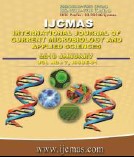


 National Academy of Agricultural Sciences (NAAS)
National Academy of Agricultural Sciences (NAAS)

|
PRINT ISSN : 2319-7692
Online ISSN : 2319-7706 Issues : 12 per year Publisher : Excellent Publishers Email : editorijcmas@gmail.com / submit@ijcmas.com Editor-in-chief: Dr.M.Prakash Index Copernicus ICV 2018: 95.39 NAAS RATING 2020: 5.38 |
Rhizoremediation is an in-situ remediation approach involving microorganisms for the biodegradation of organic pollutants and various other contaminants in the root zone. Plant roots provide a rich niche for the microorganisms to grow at the expense of the root exudates and in turn microbes act as biocatalysts to remove the pollutants. The harmful pollutants such as: polycyclic aromatic hydrocarbons (PAHs)- pesticides, herbicides etc. are converted to degradable compounds, while heavy metals such as zinc, copper, lead, tin, cadmium etc. are transformed from one oxidation state or organic complex to another. Various mechanisms employed are: producing bio-surfactants which are amphiphilic molecules that form spherical or lamellar micelles, thereby solubilizing hydrophobic contaminants in their core and enhancing their bacterial degradation to simple harmless compounds, producing metal chelating siderophores for heavy metal acquisition, increased humification, biofilm production, acid production etc. The process is affected by various- chemical, physical, biological factors i temperature, pH, soil conditions, nature of the pollutant, indigenous microflora etc. Plant -bacteria interactions play a key role in the process and are characterized by: Colonization of the roots by bacteria, maintenance of the catabolic activity and effect of the external environment conditions on the interaction. Technological advancements and increased insight into sequencing techniques can make rhizoremediation a promising and fertile future technology.
 |
 |
 |
 |
 |